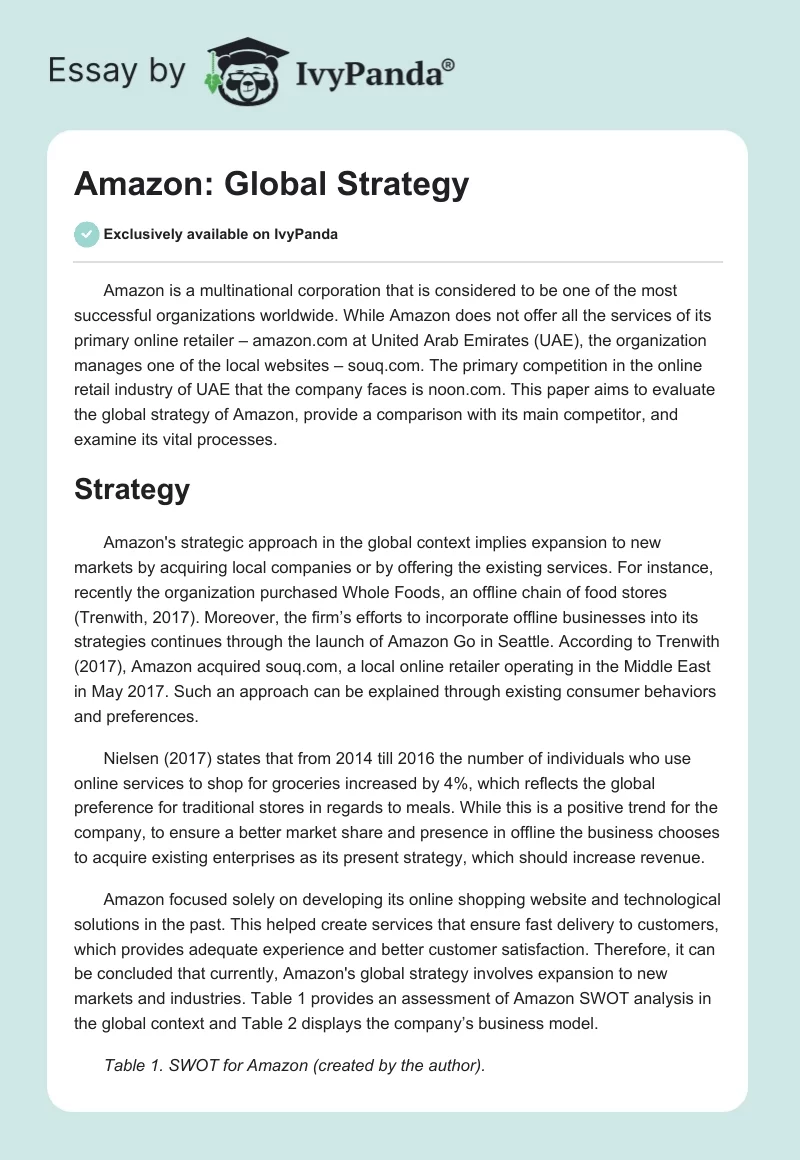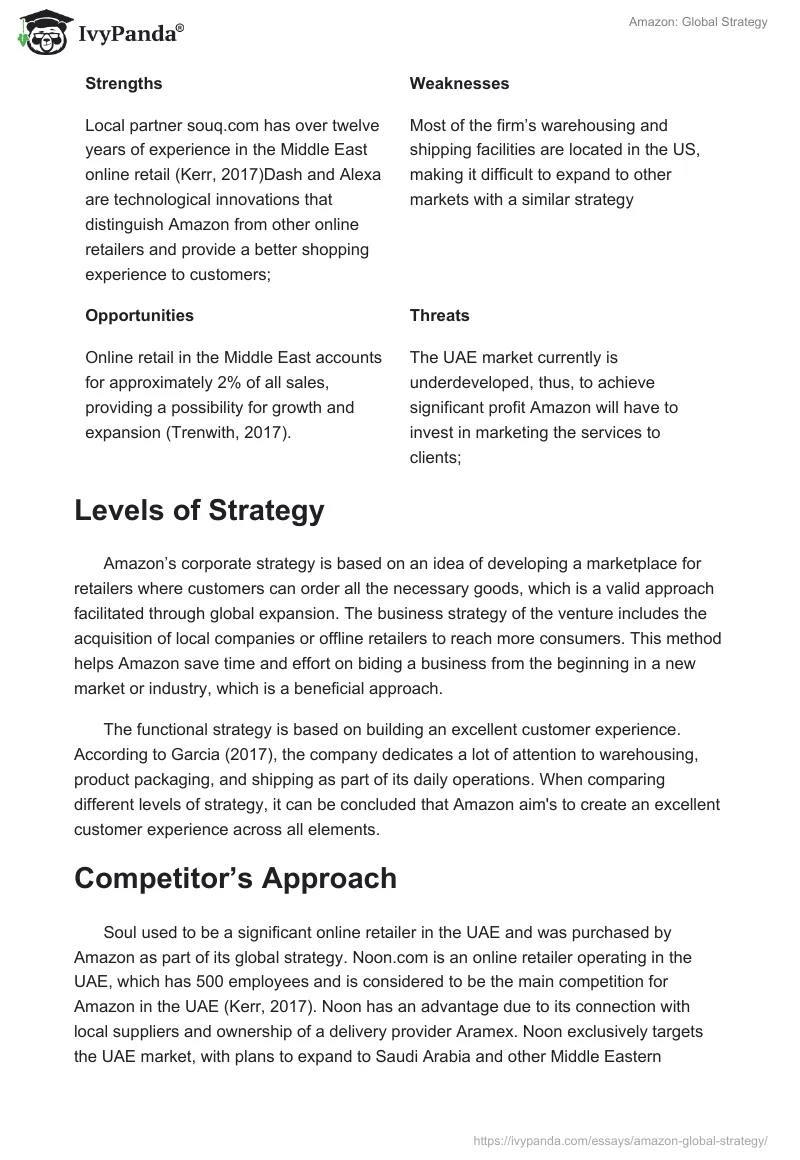Amazon is a multinational corporation that is considered to be one of the most successful organizations worldwide. While Amazon does not offer all the services of its primary online retailer – amazon.com at United Arab Emirates (UAE), the organization manages one of the local websites – souq.com. The primary competition in the online retail industry of UAE that the company faces is noon.com. This paper aims to evaluate the global strategy of Amazon, provide a comparison with its main competitor, and examine its vital processes.
Strategy
Amazon’s strategic approach in the global context implies expansion to new markets by acquiring local companies or by offering the existing services. For instance, recently the organization purchased Whole Foods, an offline chain of food stores (Trenwith, 2017). Moreover, the firm’s efforts to incorporate offline businesses into its strategies continues through the launch of Amazon Go in Seattle. According to Trenwith (2017), Amazon acquired souq.com, a local online retailer operating in the Middle East in May 2017. Such an approach can be explained through existing consumer behaviors and preferences.
Nielsen (2017) states that from 2014 till 2016 the number of individuals who use online services to shop for groceries increased by 4%, which reflects the global preference for traditional stores in regards to meals. While this is a positive trend for the company, to ensure a better market share and presence in offline the business chooses to acquire existing enterprises as its present strategy, which should increase revenue.
Amazon focused solely on developing its online shopping website and technological solutions in the past. This helped create services that ensure fast delivery to customers, which provides adequate experience and better customer satisfaction. Therefore, it can be concluded that currently, Amazon’s global strategy involves expansion to new markets and industries. Table 1 provides an assessment of Amazon SWOT analysis in the global context and Table 2 displays the company’s business model.
Table 1. SWOT for Amazon (created by the author).
Levels of Strategy
Amazon’s corporate strategy is based on an idea of developing a marketplace for retailers where customers can order all the necessary goods, which is a valid approach facilitated through global expansion. The business strategy of the venture includes the acquisition of local companies or offline retailers to reach more consumers. This method helps Amazon save time and effort on biding a business from the beginning in a new market or industry, which is a beneficial approach.
The functional strategy is based on building an excellent customer experience. According to Garcia (2017), the company dedicates a lot of attention to warehousing, product packaging, and shipping as part of its daily operations. When comparing different levels of strategy, it can be concluded that Amazon aim’s to create an excellent customer experience across all elements.
Competitor’s Approach
Soul used to be a significant online retailer in the UAE and was purchased by Amazon as part of its global strategy. Noon.com is an online retailer operating in the UAE, which has 500 employees and is considered to be the main competition for Amazon in the UAE (Kerr, 2017). Noon has an advantage due to its connection with local suppliers and ownership of a delivery provider Aramex. Noon exclusively targets the UAE market, with plans to expand to Saudi Arabia and other Middle Eastern Countries. Due to the fact that the company was launched in 2017, its past and present strategies do not differ.
Noon does not have plans to expand into offline retail, which is its primary difference with Amazon. In addition, the organization plans to operate under its brand without acquiring other companies in different countries. However, both Amazon and Noon prioritize logistics in their work (Kerr, 2017). Noon opened a fulfillment center and as was previously mentioned invests in a local delivery company. Kerr (2017) states that the Middle East market’s “online sales amounted to only $5.3bn in 2015, but that figure is forecast to rise to $20bn by 2020 with annual growth of 30 percent” (para. 10).
The primary issues in the prevalence of cash payments and poor infrastructure that obstructs delivery. These factors influence the strategies of both Noon and Amazon within the UAE market and outcomes of operations. Therefore, both companies plan on expanding to other countries in the Middle East and prioritize fast deliveries for their customers; however, noon.com does not include offline activities in their strategy.
Business Model
Table 2. The business model of Amazon (created by the author).
Value Chain
Switching Costs strategy that Amazon applies is connected to its additional services such as Prime that enable delivery. It is due to the fact that the company’s primary advantage is the variety of products and fast delivery of goods to consumers. Therefore, the switching costs are high because of Amazon’s focus on its clients because the organization aims to become a single place for shopping, either online or offline for its clients.
The type of switching costs, in this case, is relational because the customer may experience discomfort due to a change of supplier. The profit margin of the enterprise is 3,8 percent according to Ovide (2018). The primary activities of Amazon’s value chain are outbound logistics which include packaging and handling the goods. Additionally, supporting activities of Amazon’s value chain is technology because the establishment developed products such as Alexa to help consumers get better access to the firm’s products.
According to the VRIO framework, Amazon’s services are valuable because they offer a variety of products and services with convenient delivery. The rare component includes technological solutions such as Alexa and Dash, and offline food chains, which allow to diversify the value of the retailer and can be considered organization specific. Amazon’s resources are imperfectly imitable due to the long history of operations and a large number of warehouses and partner companies.
Conclusion
Overall, in the past Amazon focused on strengthening its online presence through amazon.com by improving delivery services and creating products that help customers shop easier. The current strategy of the company targets expansion to the developing markets, such as the Middle East and focus on offline facilities. This business executes this strategy by acquiring existing retailers, which allows them to leverage the existing experience and customer base.
References
Garcia, T. (2017). Amazon’s aggressive warehouse and shipping strategy is paying off. Web.
Kerr, S. (2017). Amazon buys into the Middle East. Financial Times. Web.
Nielsen. (2017). What’s in-store for online grocery shopping. Web.
Ovide, S. (2018). Being Jeff Bezos means never apologizing about profits. Web.
Trenwith, C. (2017). Revealed: Amazon’s top priority for souq.com. Arabian Business. Web.


